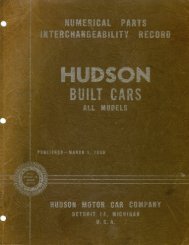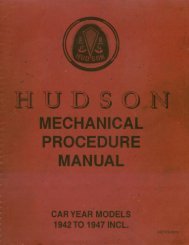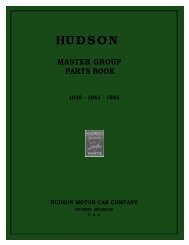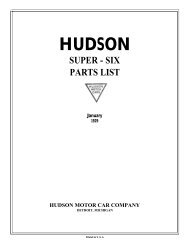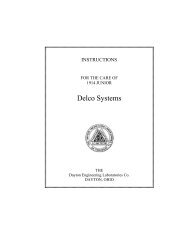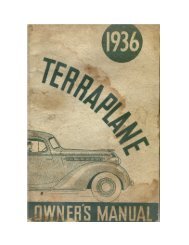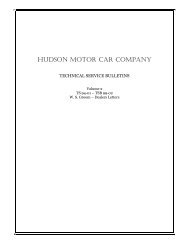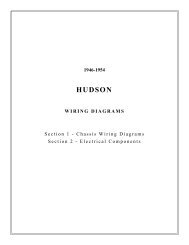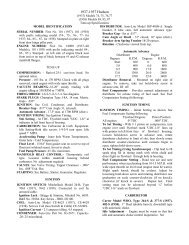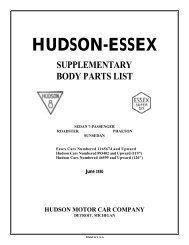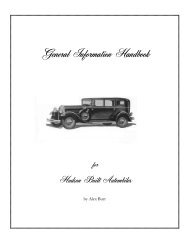1948-1952 Shop Service Manual - - Hudson-Essex-Terraplane Club
1948-1952 Shop Service Manual - - Hudson-Essex-Terraplane Club
1948-1952 Shop Service Manual - - Hudson-Essex-Terraplane Club
You also want an ePaper? Increase the reach of your titles
YUMPU automatically turns print PDFs into web optimized ePapers that Google loves.
9 - 20 OVERDRIVE<br />
REASSEMBLY - COMPLETE UNIT<br />
(Double Lever Type)<br />
1. Thoroughly clean both the transmission and overdrive<br />
cases.<br />
2. Install the transmission mainshaft bearing and oil slinger<br />
(lip to inside) on mainshaft and in the overdrive adaptor.<br />
Retain the assembly in position with the large snap ring.<br />
3. Install new shift shaft oil seals. The oil seals can be driven<br />
out from the inside of transmission c a se with a punch<br />
and tapping the new seals in place from the outside of<br />
case.<br />
NOTE: When Installing oil seals, coat outside of seal and<br />
inside of housing with red or white lead or gasket sealer<br />
to insure leak-tight joints.<br />
4. Install the low and reverse shift shaft in the transmission<br />
case. DO NOT damage the oil seal.<br />
5. Insert interlock sleeve in the transmission case and Install<br />
the interlock spring, interlock pin and one interlock ball.<br />
Align the neutral detent of the low and reverse shift shaft<br />
cam with the interlock ball and while holding the low<br />
and reverse shift shaft in position, Install the tapered pin<br />
in the case.<br />
6. Install the second and high shift shaft in the transmission<br />
case, pushing the shaft in as far as possible. Install the<br />
other interlock ball by inserting it over the interlock<br />
spring, compressing the spring and at the same time s lid<br />
in g the second. and high shift shaft toward the center of<br />
the case to its correct position.<br />
7. Install shift shift levers, short (low and reverse) on rear<br />
shaft and long (second and high) on front shaft. Move<br />
either lever into any in-gear position and with one end of<br />
the interlock sleeve contacting a shift shaft cam, measure<br />
the clearance with a feeler gauge between the opposite<br />
end of the sleeve and the c am of the other shift shaft,<br />
Figure 28. This clearance should be from .001" to .007".<br />
If not within these limits, remove sleeve and replace with<br />
one of proper length. Interlock sleeves are available in<br />
five different lengths as shown in specifications. Install<br />
taper pin retaining second and high shift shaft in case.<br />
FIGURE 28<br />
8. To Install countershaft gear cluster assembly, place needle<br />
roller spacer tube over dummy shaft and insert in cluster.<br />
Apply viscous grease between shaft and inside of gear at<br />
each end and place needle roller washers in position<br />
against each end of spacer tube. Next, insert needle rollers<br />
(22) between inside of gear and dummy shaft, followed by<br />
a retaining washer at each end.<br />
9. Coat countershaft thrust washers and ends of cluster with<br />
viscous grease and place washers in position. Install front<br />
washer with bronze face to gear and lug at top. The rear<br />
inner (bronze) thrust washer should be Installed so the<br />
lugs will engage the slots in the cluster gear and the outer<br />
(steel) thrust washer with the lug at top.<br />
10. Carefully lower cluster and assembled parts into position<br />
and enter front end of countershaft at rear of transmission<br />
case, tapping it forward while holding the front end of the<br />
dummy shaft in constant contact with the countershaft to<br />
keep needle rollers and washers in place. Drive countershaft<br />
forward just far enough to enter front end in case, as<br />
it must again be removed after checking end play.<br />
11. With a feeler gauge inserted between the rear thrust<br />
washers, check countershaft cluster end play, Figure 29.<br />
End play should range between .006" and .016"; if more<br />
than this, the thrust washers should be replaced.



